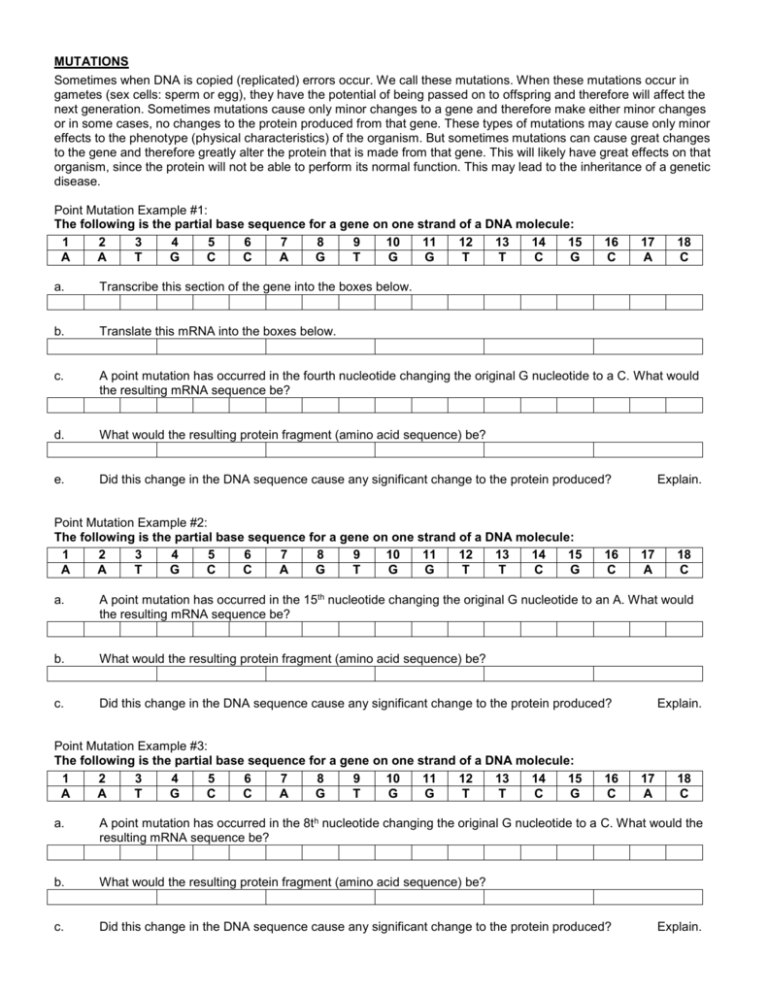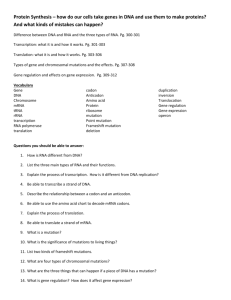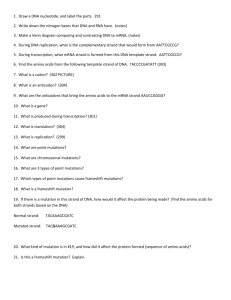Mutations Worksheet
advertisement

MUTATIONS Sometimes when DNA is copied (replicated) errors occur. We call these mutations. When these mutations occur in gametes (sex cells: sperm or egg), they have the potential of being passed on to offspring and therefore will affect the next generation. Sometimes mutations cause only minor changes to a gene and therefore make either minor changes or in some cases, no changes to the protein produced from that gene. These types of mutations may cause only minor effects to the phenotype (physical characteristics) of the organism. But sometimes mutations can cause great changes to the gene and therefore greatly alter the protein that is made from that gene. This will likely have great effects on that organism, since the protein will not be able to perform its normal function. This may lead to the inheritance of a genetic disease. Point Mutation Example #1: The following is the partial base sequence for a gene on one strand of a DNA molecule: 1 2 3 4 5 6 7 8 9 10 11 12 13 14 15 A A T G C C A G T G G T T C G 16 C 17 A 18 C a. Transcribe this section of the gene into the boxes below. b. Translate this mRNA into the boxes below. c. A point mutation has occurred in the fourth nucleotide changing the original G nucleotide to a C. What would the resulting mRNA sequence be? d. What would the resulting protein fragment (amino acid sequence) be? e. Did this change in the DNA sequence cause any significant change to the protein produced? Point Mutation Example #2: The following is the partial base sequence for a gene on one strand of a DNA molecule: 1 2 3 4 5 6 7 8 9 10 11 12 13 14 15 A A T G C C A G T G G T T C G 16 C Explain. 17 A 18 C a. A point mutation has occurred in the 15th nucleotide changing the original G nucleotide to an A. What would the resulting mRNA sequence be? b. What would the resulting protein fragment (amino acid sequence) be? c. Did this change in the DNA sequence cause any significant change to the protein produced? Point Mutation Example #3: The following is the partial base sequence for a gene on one strand of a DNA molecule: 1 2 3 4 5 6 7 8 9 10 11 12 13 14 15 A A T G C C A G T G G T T C G 16 C Explain. 17 A 18 C a. A point mutation has occurred in the 8th nucleotide changing the original G nucleotide to a C. What would the resulting mRNA sequence be? b. What would the resulting protein fragment (amino acid sequence) be? c. Did this change in the DNA sequence cause any significant change to the protein produced? Explain. Frameshift Mutation Example #1: The following is the partial base sequence for a gene on one strand of a DNA molecule: a. A frameshift mutation has occurred adding a G after the third nucleotide. Fill in the mutated DNA sequence in the boxes below. 1 2 A A Mutated to: 3 T 4 G 5 C 6 C 7 A 8 G 9 T 10 G 11 G 12 T 13 T 14 C 15 G 16 C b. What would the resulting mRNA sequence be? c. What would the resulting protein fragment (amino acid sequence) be? d. Did this change in the DNA sequence cause any significant change to the protein produced? 17 A 18 C 19 Explain. Frameshift Mutation Example #2: The following is the partial base sequence for a different gene on one strand of a DNA molecule. A frameshift mutation has occurred deleting the 8th nucleotide (G). Fill in the mutated DNA sequence in the boxes below. a. 1 T 2 A 3 C 4 A 5 T 6 A 7 A 8 G 9 T 10 T 11 G 12 G 13 A 14 C 15 C 16 A 17 T 18 C Mutated to: b. Transcribe the original gene (the non-mutated one) into the boxes below. c. Translate this mRNA into the boxes below. d. What would the resulting mRNA sequence be of the mutated strand? e. What would the resulting protein fragment (amino acid sequence) of it be? f. Did this change in the DNA sequence cause any significant change to the protein produced? QUESTION: Are mutations always deleterious (harmful)? (HINT: use page 308 to help you) Explain. Explain.







